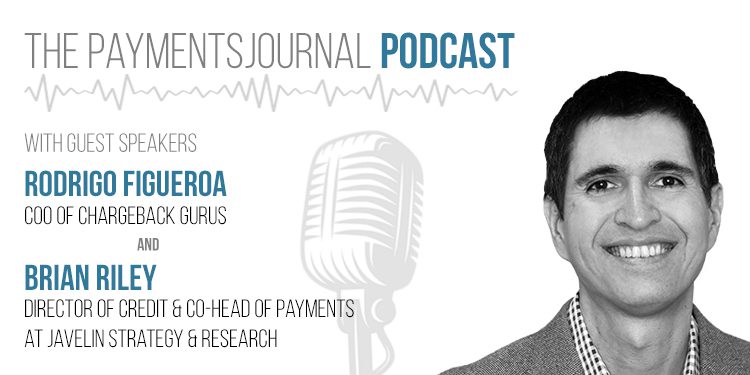Real-time payments (RTP) continue to become more of a part of everyday life for consumers. While RTP systems are more mature in other parts of the world, the U.S. is slowly catching up. The Clearinghouse launched its RTP Network in 2017, the first payments rail in the U.S. designed to handle real-time transfer of settlement and funds. The Federal Reserve is scheduled to launch its FedNow RTP service sometime in 2023.
The manner in which real-time payments evolve in the U.S. may be a bit different than in the rest of the world, however. This is due to the massive number of financial institutions in the country (more than 9,000 combined banks and credit unions) as well as a different regulatory environment.
To discuss the unique ways in which real-time payments may evolve in the U.S., PaymentsJournal recently hosted a podcast with Rodrigo Figueroa, COO of Chargeback Gurus, and Brian Riley, Director of Credit Advisory Service at Javelin Strategy & Research.
How Do Real-Time Payments Work?
Simply put, a real-time payment is when a sender initiates a payment, the RTP provider validates it, the funds are immediately settled in the receiver’s account, and a confirmation message is sent back to the sender. RTP transactions allow for open loop transfer directly between bank accounts, unlike services such as Venmo, which tap into a prepaid fund balance managed by that payment platform.
“More importantly, each bank has an immediately updated ledger; when you have a debit shown on one bank, that same position is recorded immediately on the ledger of the receiving bank,” Figueroa said.
He added that digital trends in other aspects of life and consumer expectations are forcing banks and payments providers to offer real-time payments capabilities.
“From a behavioral perspective, we are getting used to everything being in real time,” Figueroa said. “So, this isn’t coming out of nowhere.”
Eventually, we will have a global set of interoperable, connected real-time payments rails, though the industry is not quite there yet, he added.
Benefits of Real-Time Payments
Real-time payments have several benefits. The obvious one is the convenience for sender and receiver to immediately see their updated accounts after the payment is sent. Real-time payments are especially desired by those who work in the gig economy and perhaps cannot wait weeks or even a month to get paid for the work they do, Figueroa noted.
“For a lot of people, cash flow matters,” he added. “They can’t wait until the end of the month for a check.”
In general, consumers have come to expect “instant gratification. Everything on our phone is a few clicks or swipes away,” Figueroa said.
Another key benefit of real-time payments is the extra data involved in them. The payment record includes all of the data associated with the transaction, thus eliminating the confusion that can result when a pending transaction is settled with an unclear or cryptic description days after it was initiated.
Figueroa also noted real-time bill payments as a key benefit, since RTP funds settle the instant, the payment is made. This helps consumers avoid situations where they pay a bill online on the date it is due, but it doesn’t settle until a few days after that.
Challenges to Overcome
Still, real-time payments are not without their own unique challenges. One is fraud, noted Riley. Since the payments are immediately settled, criminals can engage in payments fraud and make fraudulent transactions before anyone notices.
“The easier you make it for consumers, the easier you also make it for crooks to take advantage of,” he added.
Another issue is difficulties with refunds and chargebacks, Riley added. For example, when making a payment now on the Visa or Mastercard network, it takes a few days to settle. If a consumer wants to return a faulty item or wants a refund on a service that was not provided as described, it’s easier to initiate a dispute and return the payment during this intermediate time. It becomes much more difficult in a real-time environment.
“It will be interesting to see how the regulations develop around this,” said Riley. “This is a really important piece that affects the whole ecosystem.”
This will be exacerbated by the sheer number of transactions made daily in the U.S. Riley noted the real-time payments system M-PESA in Africa, which may process 100,000 transactions a day.
“That’s similar to the volume we might get here just in the state of New Jersey,” he said. “In the whole U.S., we’re talking billions of transactions. It’s a massive amount of volume”
It’s not just sheer volume, but the unique regulatory environment in the U.S. that will make real-time payments implementation here different than in the rest of the world, noted Figueroa.
In other countries, the regulatory statutes are generally created before innovation is built, whereas in the U.S., often technology innovation gets ahead of regulations.
“I’m not saying that’s good or bad, it’s often just how it is here in the U.S.,” Figueroa noted.
On the flip side, being a bit late to the RTP game means that “the U.S. gets the benefit of looking at what happened around the world [as it relates to RTP] and seeing the good and bad and creating a better product,” he added.
Furthermore, given the fragmented nature of the U.S. financial system, there may never be one cohesive real-time payments network that everyone uses, said Figueroa.
“The U.S. may never have one standard because we have so many competing entities,” he observed. “Having such a big market allows all these elements to compete with one another. Don’t take it for granted that it will eventually all consolidate into one network, like in other countries. The key is having interoperability between all these competing networks.”














